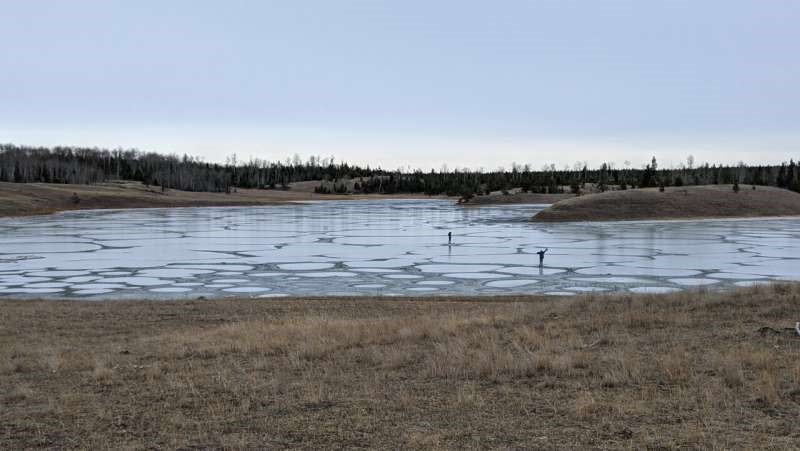Description

Disclaimer: Copyright infringement not intended.
Context
A study from the University of Washington, published this month in Communications Earth & Environment, that a shallow "soda lake" in western Canada could be a good match for Darwin's "warm little ponds" where life got started on the primordial Earth.
Details
Soda Lake
- A soda lake or alkaline lake is a lake on the strongly alkaline side of neutrality, typically with a pH value between 9 and 12.
- High carbonate concentration, especially sodium carbonate, is responsible for the alkalinity of the water.
- Many soda lakes also contain high concentrations of sodium chloride and other dissolved salts, making them saline or hypersaline lakes as well.
- Soda lakes occur naturally throughout the world, typically in arid and semi-arid areas and in connection to tectonic rifts like the East African Rift Valley.
Geology and Genesis
- Geological, climatic, and geographic requirements are required for a lake to become
- A topography that limits the outflow of water from the lake is needed.
- An endorheic basin is formed when the water is confined without the outflow.
- The pH of the water in the depression rises through the evaporation of the lake which requires a suitable climate like the desert climate to balance between the inflow and evaporation.
- The rate at which carbonate salt dissolve in the lake water depends on the ecology of the surrounding area.
- The relative absence of magnesium and calcium is critical in the formation of the soda lake since magnesium or calcium is likely to dissolve quickly and displace the carbonate ion thus neutralizing the pH of the lake water.

Biodiversity
- These are highly productive ecosystems compared to the freshwater lakes.
- These are the most productive aquatic environments on Earth and Gross primary production (photosynthesis) rates above 10 g C m−2 day−1 (grams of carbon per square meter per day), over 16 times the global average for lakes and streams (0.6 g C m−2 day−1), have been measured, this is because of the availability of dissolved carbon dioxide.
- These are dominated by prokaryotes like bacteria and archaea, especially in lakes with higher levels of alkalinity.
- Particularly in the East African Rift Valley, microorganisms in soda lakes also provide the main food source for vast flocks of the lesser flamingo.
- Multicellular organisms such as brine shrimp and fish are found in plenty if not most of the soda lakes
Ecology:
- Carbon cycle: Photosynthesis provides the primary energy source for life in soda lakes and this process dominates the activity at the surface. The most important photosynthesizers are typically cyanobacteria, but in many less "extreme" soda lakes, eukaryotes such as green algae (Chlorophyta) can also dominate.
- Below the surface, anoxygenic photosynthesizers using other substances than carbon dioxide for photosynthesis also contribute to primary production in many soda lakes.
- Sulfur cycle: Sulfur-reducing bacteria are common in anoxic layers of soda lakes. These reduce sulfate and organic sulfur from dead cells into sulfide (S2−). Anoxic layers of soda lakes are therefore often rich in sulfide.
- Sulfur-oxidating bacteria instead derive their energy from oxidation of the sulfide reaching the oxygenated layers of soda lakes.
- Nitrogen: Nitrogen is a limiting nutrient for growth in many soda lakes, making the internal nitrogen cycle very important for their ecological functioning. One possible source of bio-available nitrogen is diazotrophic cyanobacteria, which can fix nitrogen from the atmosphere during photosynthesis.
Examples of Soda Lakes
- Africa and Asia have the highest number of soda lakes since the two continents have vast desert conditions which are perfect for the formation of soda lakes.
- Most of the soda lakes in Africa are located in Eastern Africa, especially in Kenya, Tanzania, and Ethiopia.
- Lake Natron in Tanzania is one of the most outstanding soda lakes in Africa
- India and China have the highest number of soda lakes in Asia.
- Kushul lake, Namucuo Lake, Lonar Lake (Crater Lake), Sambhar Salt Lake, Khyagar Lake, Tso Moriri Salt Lake, Tso Kar Salt Lake are some of the Indian Lakes.
Recent Findings in Last Chance Lake
- Analysis published in the new paper suggests soda lakes are a strong candidate for the emergence of life on Earth. They also could be a candidate for life on other planets.
- In most lakes the dissolved phosphate quickly combines with calcium to form calcium phosphate, the insoluble material that makes up tooth enamel. This removes phosphate from the water.
- But in Last Chance Lake, calcium combines with plentiful carbonate as well as magnesium to form dolomite, the same mineral that forms picturesque mountain ranges.
- This reaction was predicted by the previous modeling work and confirmed when dolomite was plentiful in Last Chance Lake's sediments.
- When calcium turns into dolomite and does not remain in the water, the phosphate lacks a bonding partner and so its concentration rises.
- This study adds to growing evidence that evaporative soda lakes are environments meeting the requirements for origin-of-life chemistry by accumulating key ingredients at high concentrations.
- Goodenough Lake has mats of cyanobacteria that extract or "fix" nitrogen gas from the air.
- Cyanobacteria, like all other lifeforms, also require phosphate and its growing population consumes some of that lake water's phosphate supply.
- But Last Chance Lake is so salty that it inhibits living things that do the energy-intensive work of fixing atmospheric nitrogen.
- Last Chance Lake harbors some algae but has insufficient available nitrogen to host more life, allowing phosphate to accumulate. This also makes it a better analog for a lifeless Earth.

Conclusion
These new findings will help inform origin-of-life researchers who are either replicating these reactions in the lab or are looking for potentially habitable environments on other planets.
|
PRACTICE QUESTION
Q. Last Chance Lake often mentioned in news is located in which of the following country?
A.USA
B.Canada
C.Mexico
D.Brazil
Answer B
|












